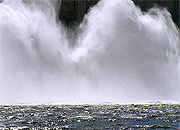Construction of the Dzhubga – Lazarevskoye – Sochi gas pipeline is progressing according to the schedule. At present, 11.8 kilometers of the onshore line pipes have been laid. Horizontal directional drilling is underway to install the pipeline landfall sections near the city of Tuapse and the Kudepsta settlement. Identical operations have been completed near the Novomikhailovskoye and Dzhubga settlements.
The Dzhubga – Lazarevskoye – Sochi gas pipeline has been included into the Program approved by the Russian Federation Government and aimed at the construction of Olympic facilities and development of Sochi as a mountain-climatic resort. The pipeline will secure reliable energy supplies to Sochi and to the Olympic facilities under construction; it will give a powerful impetus to the gasification advancement in Sochi and the Tuapse District and will considerably cut the energy deficit on the Caucasian coast of the Black Sea.
The gas pipeline will stretch 177 kilometers including a 159.5-kilometer offshore section. The pipeline route will run on the Black Sea bottom along the coastal line (around 4.5 kilometers away from the coast) to the Kudepsta gas distribution station near Sochi.
The gas pipeline landfalls will be located near Dzhubga, Novomikhailovskoye, Tuapse and Kudepsta.
The 530-millimeter pipeline will have the annual throughput capacity of some 3.8 billion cubic meters.
The gas pipeline construction was launched in September 2009. It is being carried out in a most climatically attractive and, therefore, a most cherished region of the country, the Caucasian coast of the Black Sea. In this context, Gazprom pays great attention to environmental activities to be taken during the pipeline construction.
The construction schedule has been worked out with due regard to the most important biocycles of the local fauna species and enables to maximally reduce the environmental impact caused by the construction process. The offshore option of the pipeline route has minimized allocation of industrial, agricultural and forest lands, as well as specially protected natural reservations.
The most suitable coastal line crossing procedure, horizontal directional drilling, considerably mitigates the environmental impact on the most vulnerable coastal ecosystems. As a result, it will be possible to avoid interference with the coastal wildlife area.
No operations related to the Dzhubga – Lazarevskoye – Sochi gas pipeline construction will disrupt the regional landscape, which is especially important for the animal ecosystem preservation.
It is projected to complete the pipeline construction in the second quarter of 2010.

C-Master pipe-laying barge


